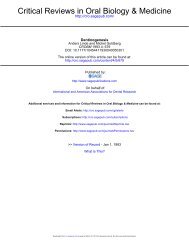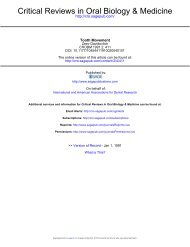Autogenous and Allogeneic Bone Grafts in Periodontal Therapy
Autogenous and Allogeneic Bone Grafts in Periodontal Therapy
Autogenous and Allogeneic Bone Grafts in Periodontal Therapy
Create successful ePaper yourself
Turn your PDF publications into a flip-book with our unique Google optimized e-Paper software.
localized juvenile periodontitis (Yukna <strong>and</strong> Sepe,<br />
1981; Evans et al, 1989). A study that compared<br />
FDB A with <strong>and</strong> without tetracycl<strong>in</strong>e to a nongraft<br />
procedure <strong>in</strong> 12 juvenile periodontitis patients<br />
demonstrated significantly greater bone fill <strong>and</strong><br />
resolution of osseous defects <strong>in</strong> grafted as opposed<br />
to control sites (Mabry et al, 1985).<br />
3. Decalcified Freeze-Dried <strong>Bone</strong><br />
Allograft<br />
Urist <strong>and</strong> co-workers showed through numerous<br />
animal experiments that dem<strong>in</strong>eralization<br />
of a cortical bone graft <strong>in</strong>duces new bone formation<br />
<strong>and</strong> greatly enhances its osteogenic potential<br />
(Urist, 1965; Urist etal, 1967; Urist <strong>and</strong><br />
Dowell, 1968; Urist etal, 1968 <strong>and</strong> 1975). The<br />
work of Urist has been confirmed by others (Kosk<strong>in</strong>en<br />
et al, 1972; Chalmers et al., 1975; Oikarien<br />
<strong>and</strong> Korhonen, 1979; Mellonig et al.,<br />
1981a <strong>and</strong> b). Dem<strong>in</strong>eralization with hydrochloric<br />
acid exposes the bone <strong>in</strong>ductive prote<strong>in</strong>s located<br />
<strong>in</strong> the bone matrix (Urist <strong>and</strong> Strates, 1970).<br />
These prote<strong>in</strong>s are collectively called bone morphogenetic<br />
prote<strong>in</strong> (BMP) (Urist <strong>and</strong> Strates,<br />
1971). They are composed of a group of acidic<br />
polypeptides that have been cloned <strong>and</strong> sequenced<br />
(Urist et al., 1983a <strong>and</strong> b; Wozney et<br />
al., 1988). In addition, there appears to be homology<br />
among bone <strong>in</strong>ductive prote<strong>in</strong>s between<br />
mammalian species (Sampath <strong>and</strong> Reddi, 1987).<br />
BMP stimulates the formation of new bone by<br />
osteo<strong>in</strong>duction (Urist et al, 1970). That is, the<br />
dem<strong>in</strong>eralized graft <strong>in</strong>duces host cells to differentiate<br />
<strong>in</strong>to osteoblasts (Harakas, 1984), whereas<br />
an undem<strong>in</strong>eralized allograft is felt to function<br />
by osteoconduction as it affords a scaffold for<br />
new bone formation (Goldberg <strong>and</strong> Stevenson,<br />
1987). The sequence of bone <strong>in</strong>duction with a<br />
dem<strong>in</strong>eralized bone graft is believed to follow a<br />
bone <strong>in</strong>duction cascade (Reddi et al, 1987; Bowers<br />
<strong>and</strong> Reddi, 1991). At day 1, there is chemotaxis<br />
of fibroblasts <strong>and</strong> cell attachment to the<br />
implanted dem<strong>in</strong>eralized bone matrix. At day 5,<br />
there is cont<strong>in</strong>ued cell proliferation <strong>and</strong> differentiation<br />
of chrondroblasts. At day 7, chrondrocytes<br />
synthesize <strong>and</strong> secrete matrix. From days<br />
10 to 12, there is vascular <strong>in</strong>vasion, differentiation<br />
of osteoblasts <strong>and</strong> bone formation, <strong>and</strong> mi-<br />
neralization. By day 21, there is bone marrow<br />
differentiation. This cascade for the <strong>in</strong>duction of<br />
endochondral bone has been shown to occur <strong>in</strong><br />
heterotopic sites of animals grafted with dem<strong>in</strong>eralized<br />
bone matrix (Reddi et al., 1987). It has<br />
not been demonstrated to occur follow<strong>in</strong>g implantation<br />
of this material <strong>in</strong> a periodontal osseous<br />
defect. A more likely scenario for the periodontal<br />
defect is the <strong>in</strong>duction of new bone<br />
through the <strong>in</strong>termembranous route (Mellonig et<br />
al, 1981b).<br />
Lib<strong>in</strong> et al (1975) were the first to report<br />
the use of cortical <strong>and</strong> cancellous decalcified<br />
FDB A (DFDBA) <strong>in</strong> humans. The three grafted<br />
sites responded with 4 to 10 mm of new bone<br />
formation. Cortical DFDBA was evaluated <strong>in</strong> 27<br />
<strong>in</strong>traosseous periodontal defects <strong>and</strong> yielded a<br />
mean of 2.4 mm of bone fill (Qu<strong>in</strong>tero et al,<br />
1982). In six cases, Werbitt (1987) showed bone<br />
fill rang<strong>in</strong>g from 75 to 95% of the orig<strong>in</strong>al defect.<br />
The results of a radiographic analysis of cancellous<br />
DFDBA <strong>in</strong> 16 patients demonstrated a<br />
mean bone fill of 1.38 mm, whereas six control<br />
sites showed 0.33 mm (Pearson et al, 1981).<br />
The reason for this meager bone fill after a graft<br />
of cancellous DFDBA may lie <strong>in</strong> the fact that the<br />
bone <strong>in</strong>ductive prote<strong>in</strong>s are located <strong>in</strong> the bone<br />
matrix (Urist <strong>and</strong> Iwata, 1973). Because the mass<br />
of bone matrix is lower <strong>in</strong> cancellous bone than<br />
that <strong>in</strong> cortical bone, the yield of new bone could<br />
be expected to be lower with cancellous than<br />
cortical bone (Urist et al, 1970). Another controlled<br />
study <strong>in</strong> 47 periodontal osseous defects<br />
demonstrated a mean bone fill of 2.6 mm (65%<br />
defect fill) <strong>in</strong> sites treated with cortical DFDBA<br />
<strong>in</strong> comparison with 1.3 mm (38% defect fill) <strong>in</strong><br />
sites treated without DFDBA.<br />
Rummelhart et al (1989) cl<strong>in</strong>ically compared<br />
DFDBA <strong>and</strong> FDB A <strong>in</strong> 11 paired sites. No<br />
statistical difference <strong>in</strong> prob<strong>in</strong>g depth reduction,<br />
cl<strong>in</strong>ical attachment ga<strong>in</strong>, or bone fill was reported,<br />
which might have been reflective of <strong>in</strong>sufficient<br />
<strong>in</strong>ductive bone prote<strong>in</strong> <strong>in</strong> DFDBA or<br />
the types <strong>and</strong> depths of the grafted lesions. Additional<br />
factors might also have <strong>in</strong>fluenced the<br />
decision to use a m<strong>in</strong>eralized or dem<strong>in</strong>eralized<br />
preparation. The process<strong>in</strong>g of both preparations<br />
<strong>in</strong>cluded multiple immersions <strong>in</strong> absolute ethanol.<br />
The DFDBA underwent further process<strong>in</strong>g that<br />
<strong>in</strong>cluded immersion <strong>in</strong> 0.6 N HC1 (Mellonig,<br />
Downloaded from<br />
cro.sagepub.com by guest on January 10, 2013 For personal use only. No other uses without permission.<br />
339




